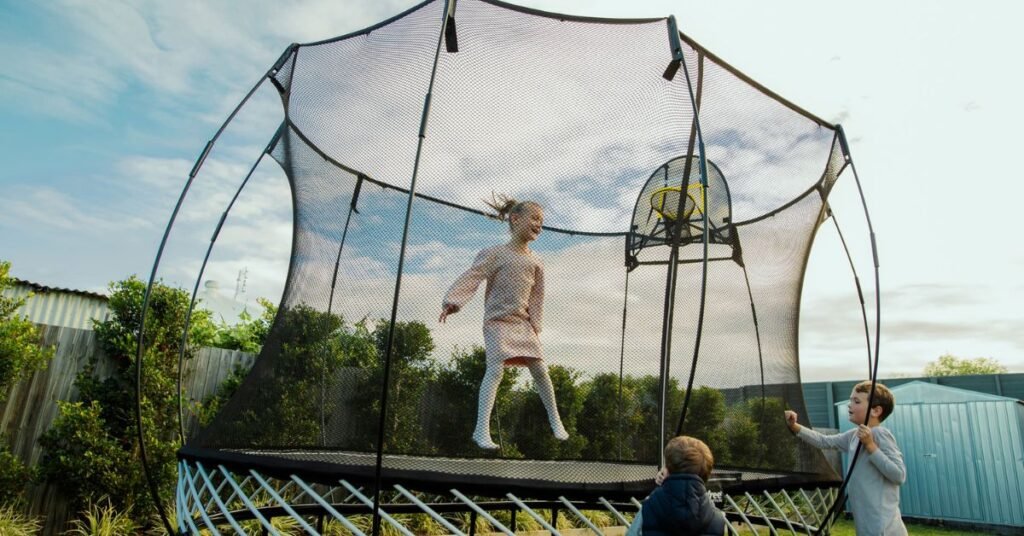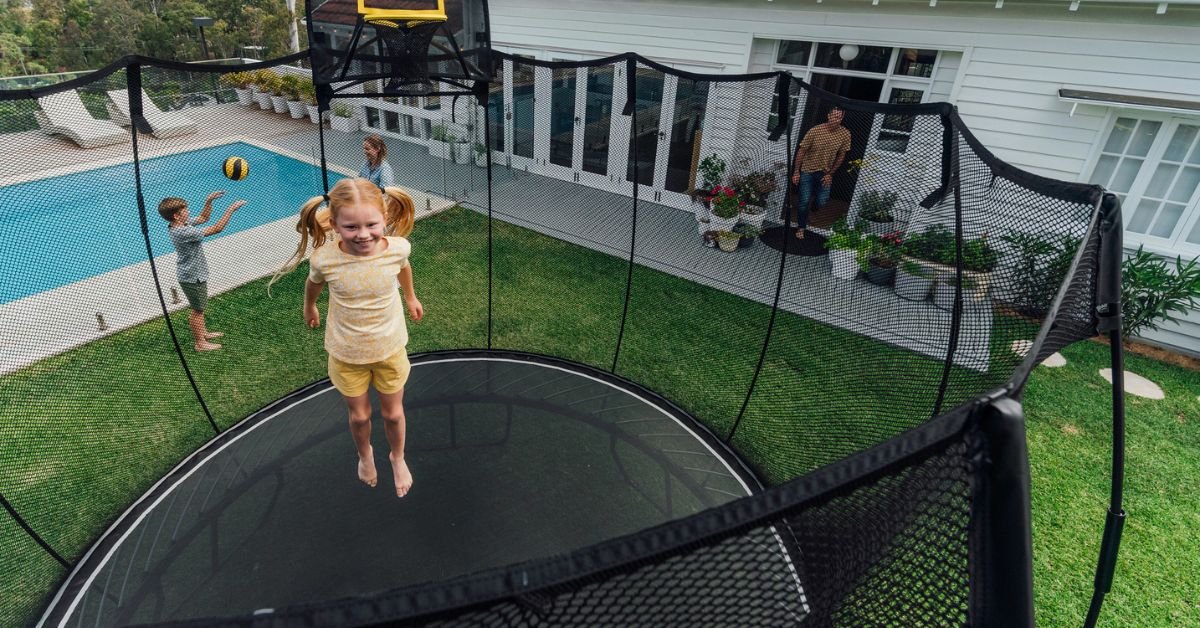Are you worried about your trampoline surviving the cold winter months? Keeping your trampoline in good shape during winter isn’t as hard as it seems.
With the right steps, you can protect your trampoline from snow, ice, and freezing temperatures. This means when spring arrives, your trampoline will be ready for fun without any damage or extra repairs. Keep reading to discover simple, effective tips that will help you maintain your trampoline all winter long and save you time and money.
Your trampoline deserves the best care—let’s make sure it gets it!
Preparing The Trampoline For Winter
Winter can damage your trampoline if you do not prepare it properly. Taking time to get it ready helps protect it from snow, ice, and cold weather.
Follow these steps to keep your trampoline safe and ready for use when spring comes.
Cleaning The Surface And Frame
Start by cleaning the trampoline surface and frame. Dirt and debris left on the trampoline can cause damage during winter.
Use a soft brush or cloth and mild soap with water to clean the mat and frame. Avoid harsh chemicals that can weaken materials.
- Remove leaves, dirt, and dust from the surface
- Wipe down the metal frame to prevent rust
- Let everything dry completely before covering
Inspecting For Damage
Check the trampoline for any signs of damage before winter. Small problems can get worse with cold and snow.
Look for tears in the mat, loose springs, or rust on the frame. Fix these issues or plan to repair them in spring.
- Look closely at the jumping mat for holes or tears
- Check the springs and joints for signs of wear
- Examine the frame for rust or bending
- Note any parts that need repair or replacement
Removing Accessories
Take off any accessories before winter to avoid damage. These parts can break or cause harm if left outside.
Remove nets, ladders, and covers. Store them in a dry place to keep them in good shape until spring.
- Remove the safety net and poles
- Take off the ladder and store it indoors
- Remove any trampoline covers or tarps
- Keep all parts dry and safe from weather

Protecting The Trampoline
Winter weather can harm your trampoline if you do not protect it. Snow, rain, and cold can cause damage. Taking care of your trampoline helps it last longer.
Use simple steps to keep your trampoline safe during winter. Cover it well, secure its parts, and stop rust from forming.
Using A Weatherproof Cover
A weatherproof cover shields the trampoline from snow and rain. It keeps the jumping mat dry and clean. Use a cover made for outdoor use.
Make sure the cover fits tightly. Loose covers can blow away in strong wind. Check the cover often and fix it if needed.
- Choose a thick, waterproof material
- Cover the entire trampoline surface
- Secure edges to prevent wind from lifting it
- Remove the cover only when the weather is clear
Securing The Frame Against Wind
Strong winds can move or damage your trampoline frame. Use anchors or weights to keep it steady. Check the frame and tighten all bolts.
Place the trampoline in a sheltered area if possible. Avoid open spaces where wind is stronger. Keep the frame stable to avoid accidents.
- Use ground anchors or stakes to hold the legs
- Attach sandbags or weights to the frame
- Inspect the frame for loose parts regularly
- Store the trampoline indoors if wind is too strong
Applying Rust Prevention
Metal parts can rust in wet winter conditions. Clean the frame before winter to remove dirt and moisture. Apply a rust-preventive spray to protect the metal.
Check the frame in spring for any signs of rust. Fix small rust spots quickly to stop them from spreading. Rust prevention helps the trampoline last many years.
- Clean the metal frame before winter storage
- Use a rust-resistant spray or paint
- Dry the frame after rain or snow
- Inspect and repair rust spots each season
Storing The Trampoline
Keeping your trampoline safe in winter helps it last longer. Storing it properly stops damage from cold and moisture.
Good storage keeps the frame, springs, and mat in top shape until spring returns.
Disassembling The Trampoline
Take apart the trampoline carefully to avoid damage. Start by removing the safety net and poles.
Next, detach the springs and then separate the frame pieces. Fold the jumping mat neatly.
- Remove safety net and poles first
- Detach springs with spring tool
- Disassemble frame sections
- Fold mat and padding carefully
Choosing A Storage Location
Select a dry place to keep your trampoline parts. Avoid areas with dampness or direct sunlight.
A garage, shed, or basement works well. Make sure the space is clean and free from pests.
- Choose a dry, sheltered area
- Keep away from moisture and sunlight
- Use clean, pest-free spaces
- Ensure enough room for parts
Proper Storage Techniques
Store trampoline parts on pallets or shelves to keep them off the ground. Cover mats and padding with a breathable cloth.
Keep metal parts dry to stop rust. Check on stored parts occasionally during winter.
- Place parts off the floor
- Cover mats with breathable fabric
- Keep metal parts dry and rust-free
- Inspect storage monthly

Winter Safety Tips
Keeping your trampoline safe in winter requires special care. Cold weather and snow can cause damage if you do not maintain it well.
Follow simple steps to protect your trampoline from winter hazards. This helps extend its life and keeps it safe to use.
Avoiding Snow And Ice Buildup
Snow and ice can make the trampoline unsafe and heavy. Remove them regularly to avoid damage and accidents.
- Use a soft broom to clear snow gently from the surface.
- Do not use sharp tools that can tear the trampoline mat.
- Remove ice by letting it melt naturally or using warm water carefully.
- Cover the trampoline with a weatherproof cover when not in use.
- Check the cover often to prevent snow piling up on top.
Checking For Structural Integrity
Winter weather can weaken trampoline parts. Inspect the frame, springs, and mat for any damage or wear.
| Part | What to Check |
| Frame | Look for rust, cracks, or bends |
| Springs | Check for stretching, rust, or breaks |
| Mat | Inspect for tears, holes, or loose stitching |
| Padding | Ensure it covers springs and is not torn |
Monitoring Weather Conditions
Stay informed about weather changes that affect your trampoline. Strong winds and heavy snow can cause serious harm.
Tips to monitor weather safely:
- Check local weather forecasts daily during winter.
- Take down the trampoline if high winds are expected.
- Clear snow after each snowfall to prevent buildup.
- Keep the trampoline away from ice patches or flooding areas.
Preparing For Spring Use
Winter can be hard on your trampoline. Cold weather and snow may cause damage. Preparing it for spring use helps keep it safe and fun.
Taking time to check and clean your trampoline ensures it lasts longer. Here are key steps to get it ready after winter.
Reassembling The Trampoline
Start by putting all parts back in place. Make sure the frame is stable and all springs are attached correctly. Use the original instructions if needed.
- Lay out all trampoline parts on a clean surface.
- Connect the frame pieces tightly and securely.
- Attach the springs evenly around the mat.
- Fix the safety net and pads carefully.
- Check for any loose bolts or screws.
Inspecting And Repairing Components
Check every part for damage before use. Look for tears, rust, or broken pieces. Fix small problems early to avoid bigger repairs.
| Component | What to Check | Action |
| Jumping Mat | Tears or holes | Patch or replace |
| Springs | Rust or stretch | Replace if weak |
| Frame | Bent or rusted spots | Clean or repair |
| Safety Net | Holes or loose straps | Sew or replace |
| Padding | Cracks or wear | Replace padding |
Cleaning And Maintenance
Cleaning your trampoline keeps it safe and looking good. Remove dirt, leaves, and moisture before use. Use gentle tools and cleaners.
- Use a soft brush to remove dirt and leaves.
- Wipe the frame with a damp cloth to stop rust.
- Clean the mat with mild soap and water.
- Let all parts dry completely before use.
- Store the safety net and pads in a dry place if removable.

Frequently Asked Questions
How Do I Protect My Trampoline From Snow Damage?
Remove accumulated snow regularly to prevent frame bending and mat sagging. Use a broom or soft brush for gentle clearing. Avoid sharp tools that can tear the trampoline surface.
Should I Cover My Trampoline During Winter?
Yes, use a breathable trampoline cover to protect against snow, ice, and debris. This helps prevent moisture buildup and prolongs the trampoline’s lifespan during harsh weather.
Can I Leave The Trampoline Outside All Winter?
It’s best to disassemble or secure the trampoline firmly. Strong winds and heavy snow can cause damage if left unsecured. Store parts indoors if possible for better protection.
How Do I Maintain The Trampoline Frame In Cold Weather?
Check the frame for rust and apply a protective spray if needed. Clean and dry the frame regularly to prevent corrosion caused by moisture and cold temperatures.
Conclusion
Winter trampoline care keeps it safe and lasting longer. Cover it properly to protect from snow and moisture. Regularly clear off any snow buildup. Inspect for any wear and tear. Tighten loose screws and replace damaged parts. Store small parts safely indoors.
Safety checks are essential before each use. Routine maintenance prevents costly repairs. Enjoy peace of mind knowing your trampoline is ready for spring. Happy bouncing!